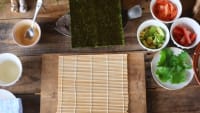Description
In this course, you will :
- Kaiseki evolved from the multicourse dining style practised by Zen monks in mediaeval Japan. This elaborate meal, similar to a tea ceremony, is intended to slow the mind and attune the senses. Niki explains her modern take on kaiseki.
- You'll need authentic ingredients to make great Japanese food. Niki offers advice on where to find and choose traditional Japanese ingredients.
- Learn how to make dashi, a deceptively simple broth that's a staple of Japanese cooking and the foundation for many dishes.
- Many of the techniques you'll learn in this class will require the use of specialised tools. Niki provides an overview of the essentials and shares some of her personal favourites.
- Learn how to confidently handle a whole fish as Niki shares a few professional tricks and demonstrates key knife skills.
- The arrangement and composition of your dishes are important aspects of the dining experience. Niki explains how to make your meals more balanced.
- Niki combines Western ingredients with Japanese technique as she prepares, cures, and slices rockfish for this sashimi dish.
- Learn how to make a delicious soup using no-waste cooking methods. Niki reveals her broth-making secrets as well as how to plate a bowl of soup.
- Discover how to identify tuna parts, how to section the meat, and where to find ethically sourced fish.
- Demonstrates professional techniques for slicing fish and making beautiful vegetable garnishes to help you improve your knife skills.
- When grilling, the type of fuel you use has an impact on the final flavour. Learn the slow, subtle technique of grilling over binchotan, a type of Japanese charcoal.
- In the middle of a meal, a light, steamed dish provides a heartwarming lift. Steamed rockfish with potato purée and ankake sauce is prepared by Niki.
- From choosing the right flour to keeping your batter cold, master the art of tempura frying. Niki recommends which vegetables and mushrooms are best for tempura.
- In this dry-fried preparation, Niki makes a simple marinade for tuna. When should you fry fish and when should you save it for sashimi?
- Introduces the donabe, a traditional clay pot, and shows how to use it while discussing the importance of rice in Japanese culture.
- The final course in kaiseki is frequently a simple bowl of rice with pickles. Discover how to make the perfect bowl of rice and how to repurpose dashi for pickle brine.
- Cooking is about inviting people in, appreciating a shared moment, and spending time together. Niki shares her personal hospitality philosophy and encourages you to find your own cooking inspirations.
Syllabus :
- Kaiseki Cooking
- Japanese Pantry Essentials
- Ichiban Dashi: Kombu and Bonito Stock
- Japanese Culinary Tools
- Rockfish: Whole Fish Preparation
- Balance in Kaiseki
- Zukuri: Modern Rockfish Sashimi
- Owan: Soup With Bone Broth
- Tuna: Portions for Otsukuri and Yakimono
- Otsukuri: Traditional Tuna Sashimi
- Yakimono: Grilled Tuna
- Mushimono: Steamed Rockfish
- Agemono: Rockfish and Vegetable Tempura
- Agemono: Tuna Karaage
- Donabe: Japanese Rice Traditions
- Shokuji: Rice and Pickles
- Ichigo Ichie









